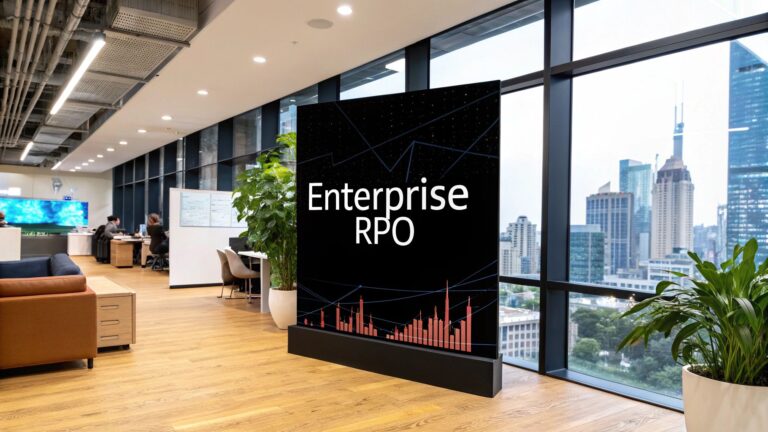Introduction
Talent acquisition has become a strategic necessity for companies that are trying to attract the best employees and obtain a competitive edge in today’s fiercely competitive labor market. Talent acquisition is changing quickly as more companies realize how important talent is and how it can help them reach their desired destination with success.
HR departments are prioritizing the talent of their employees over anything else. There is a success strategy for everyone that will lead to the stairs of success with the correct algorithm. Dive with us into this blog to learn effective strategies for success and how you can recruit, hire, and retain top talent by optimizing their talent acquisition processes.
What is talent acquisition?
The main goal of talent acquisition is to draw candidates to an organization and choose the best fit for the position and organization.
You need to create a good applicant pipeline, build employer branding, employ people for available roles, plan future resources, and broaden the labor force. When done correctly, this reduces turnover and increases productivity as well as engagement.
The people strategy (or HR strategy) and the talent acquisition plan ought to be in sync. This approach, in turn, should be consistent with the overall organizational strategy. It is currently a distinct team or a division of HR in the majority of firms and is a crucial component of people strategies.
Differences Between Talent Acquisition and Recruitment
There is something in common in the usage of the terms talent acquisition, recruitment, corporate recruitment, and strategic recruitment interchangeably. Although the main objective of both talent acquisition and recruitment is to fill open positions within an organization, there are some significant distinctions. The goal of talent acquisition is longer-term and it involves a more strategic process to find highly qualified candidates for positions that are difficult to fill and to anticipate future staffing needs.
On the other hand, hiring and recruitment are typically a temporary, operational process to cover employee openings. Generally, recruiters fill roles that are in constant demand or are not anticipated to be challenging to fill. While talent acquisition needs more preparation and time to comprehend the various departments and roles, as well as the particular combination of abilities and experience needed for each role to be successful, In addition to these and many other practices, talent acquisition also involves employer branding, recruitment process outsourcing, recruitment process optimization, and strategic recruiting.
Talent Acquisition Strategy
While you talk about talent acquisition and recruitment strategies, it is essential to stay current with both current trends and future projections when developing an effective talent acquisition strategy. According to the India Skills Report (ISR 2023), this is an overview of India’s skills and talent economy by 2030. Let’s dive into some of the talent acquisitions.
strategies that will be useful while you plan and look out for talent acquisition.
- Build a strong employer brand
Creating and sustaining a strong employer brand is an essential first step in a talent acquisition strategy. In addition to drawing in prospective employees, a strong employer brand establishes the tone for the values and culture of the company. Having a strong and genuine employer brand makes it simpler for businesses to draw in top talent who can share their goals and objectives with your business and grow together.
Employer branding highlights the distinctive qualities of the values, culture, and career development opportunities at work. Employ a variety of platforms, including social media, corporate websites, and employee endorsements, to project a compelling and recognizable employer brand. Putting money into your employer’s brand helps you attract candidates who share your values and lays the groundwork for a successful talent acquisition strategy.
- Utilize advanced technology
In the era of digital transformation, talent acquisition and recruitment processes must be streamlined and optimized through the use of advanced technology. AI-driven recruiting tools, data analytics platforms, and application tracking systems can all greatly increase productivity by streamlining repetitive processes, evaluating applicant data, and offering insightful analysis.
These technologies will save recruiters time as well as help them make better decisions. AI systems can evaluate resumes, forecast a candidate’s chances of success, and even support objective hiring procedures. Technology can be incorporated into talent acquisition to improve hiring quality while also speeding up the hiring process.
- Cultivate diversity and inclusion
Inclusion and diversity are now essential elements of a successful talent acquisition strategy. A diverse workforce encourages innovation and creativity within the company by bringing a range of perspectives and ideas to the table. Companies should start promoting inclusive hiring practices, making sure that everyone, regardless of background, feels valued and welcomed, to get the best candidates out of the pool.
Targeted outreach to underrepresented groups, inclusive interview procedures, and bias-free job description revisions are a few examples of diverse talent acquisition recruitment tactics. Organizations can improve their employer retention by adding a brand and fostering a dynamic and resilient workplace by cultivating diversity and inclusion.
Elevate your organization’s success by embedding a talent acquisition strategy
Embedding a talent acquisition strategy that works is a journey that requires dedication, flexibility, and in-depth knowledge of organizational and individual needs. Diversity and inclusion, utilizing advanced technology, workforce planning, succession planning, learning and development, and performance management can all be integrated to help organizations create a comprehensive talent management strategy that drives success.
Before diving into this project, think about utilizing the capabilities of a digital hiring platform such as Taggd. We can support your talent acquisition efforts by providing your company with access to the most qualified candidates and employee retention strategies for long-term growth and success. It’s important to keep in mind that developing effective talent management takes time, and keeping up with new trends and technologies can help your company become recognized as a leader in luring, nurturing, and keeping exceptional employees.









